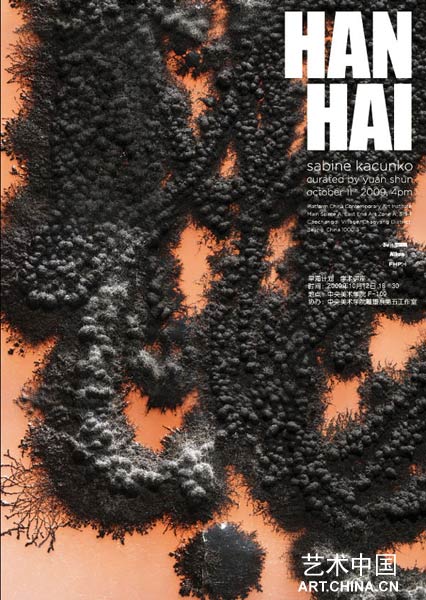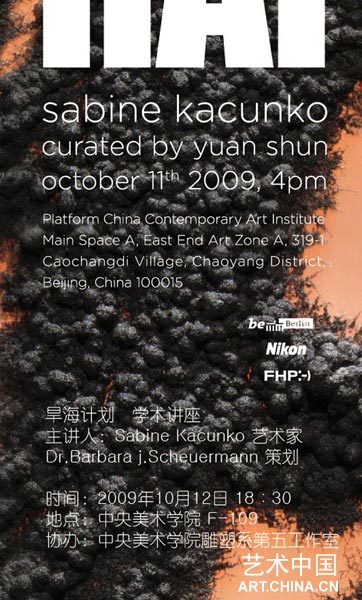
Sabine Kacunko——旱海
交互式媒介項目
策展人:袁順
開幕時間:2009.10.11 4pm
展覽地點(diǎn):站臺中國當(dāng)代藝術(shù)機(jī)構(gòu)B空間
站臺中國將于10月11日推出德國藝術(shù)家Sabine Kacunko的交互式媒介項目 - 旱海,此次展覽僅維持一天,歡迎您屆時參加。
項目背景: 對交互式媒介表現(xiàn)的“旱海”概念是BOOTSCHAFT的全球性多媒體項目,集中注意于公開對象或公共場所的特別文化或生態(tài)學(xué)的重要性。
用交互式媒介表現(xiàn)“旱海”概念的首要任務(wù)是以回應(yīng)創(chuàng)造經(jīng)濟(jì)增長和環(huán)境可持續(xù)發(fā)展的21世紀(jì)的挑戰(zhàn)。 在全球許多國家,人們目擊了一部分由人為造成沙漠化的過程。
“旱海”的焦點(diǎn)|交互式媒介表現(xiàn): “旱海”使用一個攝影顯微鏡作為交互式媒介設(shè)施的參考資料來源,沙漠的圖象數(shù)據(jù)將被顯示在交互式的室內(nèi)設(shè)施上,沙漠的風(fēng)景片段被輸入了一個城市環(huán)境。沙漠古色的微觀世界數(shù)字圖象將被生成在展廳的墻壁上。當(dāng)?shù)谝粋€觀眾來到,畫廊墻壁的表面上可見古黃色沙漠的圖像,當(dāng)越來越多的觀眾進(jìn)入這個房子,越來越多的片斷將蔓延在屏幕上,然后不斷的退化直到圖像完全消失。
裝置和交互媒介表現(xiàn)了健康的生態(tài)和經(jīng)濟(jì)發(fā)展之間的平衡關(guān)系,媒介表現(xiàn)了象征性地移植“中國的綠色墻壁的消失”,從農(nóng)村到城市的環(huán)境變化,表明成功和失敗的條件取決于那些與環(huán)境有意識互動的人的活動。沙漠荒蕪的不斷擴(kuò)大, 觀眾的參與在這個過程中起到了很大作用。不禁讓我們意識到,當(dāng)我們在傷害自然的同時,自然也會傷害我們。


Sabine Kacunko
Dry Sea
Interactive media performance
Curator: Yuan Shun
Opening Date:2009.10.11 4pm
Venue:Platform China Contemporary Art Institute Space B
Platform China Contemporary Art Institute is pleased to hold Sabine Kacunko interactive media performance – Dry Sea.
Artist Sabine Kacunko took the poetic Chinese name for Ghobi desert “han-hai” (“Dry Sea”), as title for her new work which she specially developed for Platform China in Beijing. In her multilayer spatial installation the artist touches central sociopolitial and environmental questions and leads directly into existential considerations about the relationship between humans and nature which today is characterized by an increasing tension.
For “Dry Sea” Sabine Kacunko, in cooperation with international scientists, created image files of experimental desert varnish production attempts using a microscope. These image files are the source material for the interactive spatial installation “Dry Sea”. The microcosm of desert varnish is rear-projected on a screen whose proportions in the exhibition space remind of a wall. In the beginning of the performance of “Dry Sea” the greyish desert varnish is visible as “all-over” on the screen. A camera records all visitors as long as they move behind the projection wall. This information is forwarded to a computer on which the images of the desert varnish are saved. The image files are controlled by a software which was specially developed for this installation. The more people enter the room, the more fragemented the image on the screen gets, the patina regresses, until it, resp. its image, has completely disappeared. The references and thought-provoking impulses the work provides reflect the sensitive ecological and economic balance which holds the world we live in and which is to maintain resp. to rebuild. With her visually impressive interactive installation “Dry Sea” Sabine Kacunko does not only visualize the mystic beauty of natural processes but also the efficacy of human actions.
Sabine Kacunko (born in Kassel, Germany, lives and works in Berlin) has been focussing on the complex relationship between human and nature for a long time now. Her photographs of plants, minerals and animals are created exclusively with natural light and in black-white. Seemingly familiar things unfold an unexpected power and provide space for numerous associations which are subtly guided by the artist’s attempt to fathom the world and our relation to it. Since 2005, Sabine Kacunko has been pursuiting the multimedia-based global project BOOTSCHAFT in public spaces. By using complex artistic set-ups BOOTSCHAFT draws attention to objects with a special cultural and ecological background and thus to essential sociopolitical and environmental contexts. For more information please see www.sabinekacunko.de.
(text by Barbara J. Scheuermann)?
Desert varnish is a product of rock weathering or biopitting and functions like a multilayered finely interwoven carpet of microscopic scale. The protective pigments of desert organisms absorb solar radiation in a different way from pure rock and thus help to equilibrate the albedo and hereby stabilise climatic conditions. If it were possible to artificially initiate the biofilm growth of desert varnish one could possibly counteract desertification to some extent.
The project is supported by the mayor of Berlin, chancellery of the Berlin senate, cultural affairs. Freie Universit?t, Berlin, Charité Berlin. Nikon Germany, Panasonic Germany.
The exhibition is accompanied by a lecture by Sabine Kacunko and Barbara J. Scheuermann (independent curator, Berlin) at The Central Academy of Fine Arts (CAFA), Beijing, Huajiadi Nanjiestr. 8, Chaoyang District, 100102 Beijing VR China, on October 12th 2009, 6:30pm.